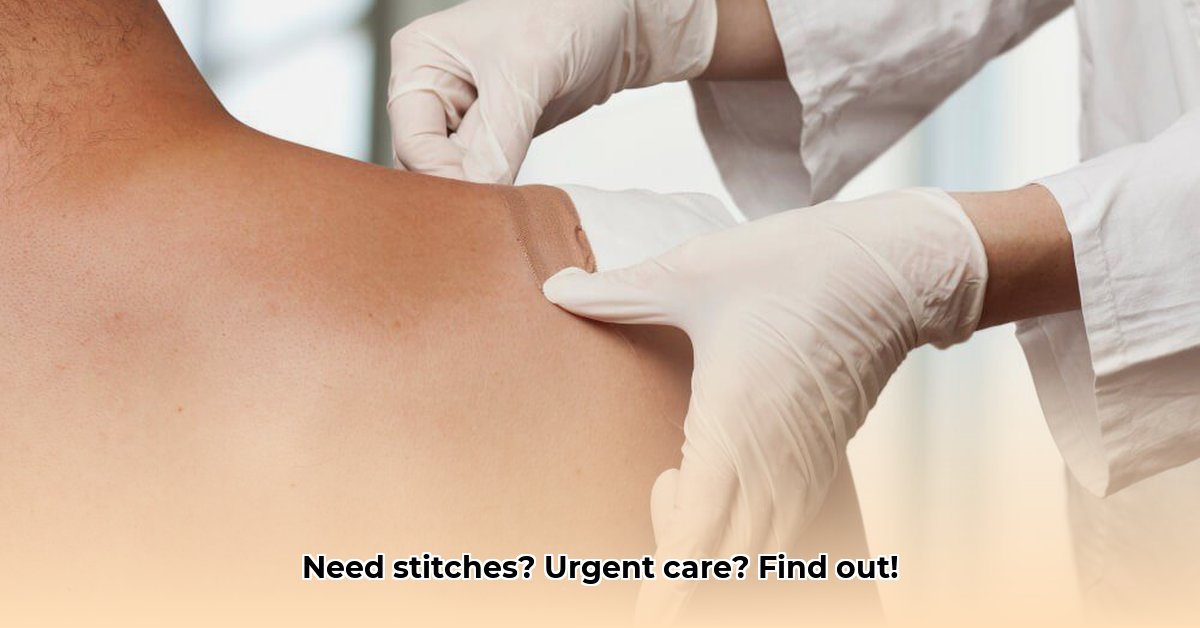
Need stitches? Choosing between urgent care and the emergency room (ER) can be confusing. This guide helps you decide quickly and confidently, ensuring you receive the right care for your wound. We'll outline when urgent care is sufficient and when the ER is necessary. We'll cover everything from identifying suitable injuries for urgent care to knowing what to expect at both facilities.
When to Go to Urgent Care for Stitches
Urgent care centers are well-equipped to handle many minor wounds requiring stitches. Consider urgent care if your wound is:
- Less than an inch deep: Shallow cuts with clean edges are typically treatable at urgent care.
- Bleeding easily controlled: Apply pressure and if bleeding stops relatively quickly, it's a good sign.
- No signs of infection: The area should be free of redness, swelling, pus, or excessive oozing.
- Not near a joint or vital area: Avoid urgent care for wounds that may affect the function of a joint or are close to major arteries.
These are examples of minor injuries that urgent care facilities effectively manage. However, remember that not all urgent care facilities provide stitching services, so it's always best to call ahead.
When to Go to the ER for Stitches
Some wounds require immediate, specialized care in the emergency room. Go to the ER if:
- Deep wound: You can see fat, muscle, or bone.
- Severe bleeding: The bleeding is heavy, spurting, or gushing, and difficult to control.
- Wound near a joint or vital area: Injuries to the face, neck, or near major arteries need immediate attention.
- Embedded object: Do not attempt to remove any object embedded in the wound; this requires professional removal.
- Signs of infection: Redness, swelling, intense pain, and pus indicate infection and need prompt treatment.
- Numbness or tingling: This could indicate nerve damage requiring specialized care.
- Weakened immune system: Even minor wounds pose a higher infection risk for those with compromised immune systems.
These situations demand immediate, specialized attention to prevent complications.
Urgent Care vs. ER: A Side-by-Side Comparison
Here's a quick comparison to aid your decision:
| Feature | Urgent Care | Emergency Room |
|---|---|---|
| Wait Times | Shorter | Significantly longer |
| Cost | Less expensive | More expensive |
| Services Offered | Minor wound care, sometimes stitches | Comprehensive emergency care, surgery if needed |
| Atmosphere | Generally less stressful | Can be busy and stressful |
What to Expect at Each Facility
Urgent Care: Expect paperwork, a wound examination, and potentially stitches if deemed appropriate. The medical professional will clean the wound thoroughly before administering any treatment. Be sure to ask questions and obtain clear post-care instructions.
ER: Prepare for a longer wait. Expect a thorough evaluation, including potential X-rays or CT scans. You might see a team of professionals working together. The level of care depends on the severity of the injury, which might lead to a longer waiting time.
Post-Wound Care: Essential Steps for Healing
Regardless of where you receive stitches, proper aftercare is crucial for preventing infection and promoting healing. Keep the wound clean and dry, and follow your doctor's instructions carefully, which may include:
- Regular cleaning
- Dressing changes
- Pain management
Watch for signs of infection (increased pain, swelling, redness, or pus). Contact your doctor or return to the facility immediately if you notice any of these signs.
Does Urgent Care Do Stitches? The Final Verdict
While urgent care can handle some wounds requiring stitches, the suitability depends entirely on the injury's type and severity. Understanding this distinction helps you make informed choices, saving you time, money, and potential health risks. Use this guide as a starting point, but remember that every situation is unique. When in doubt, consult a medical professional to assess your specific needs. This information is not a substitute for professional medical advice.
Key Takeaway: Prioritize the severity of your injury. Minor wounds often suitable for urgent care, while serious injuries necessitate immediate ER attention for optimal care. Always follow post-care instructions carefully to ensure proper healing.